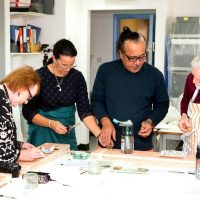
Two local siapo atists, Regina Meredith Fitiao of the American Samoa Community College and Su’a Uilisone Fitiao of Pacific Horizons School recently led a workshop on one of Samoa’s ancient artforms siapo at Scotland’s University of Glasgow.
The pair, both long-recognized as cultural artists and educators, traveled to Scotland last month to demonstrate both the making of barkcloth as well as its uses as an artistic medium.
They worked in collaboration with Project Leads Dr. Frances Lennard, Professor of Textile Conservation, and Dr. Adrienne Keppler Curator of Oceanic Ethnology at the National Museum of Natural History Smithsonian Museum Washington D.C.
Meredith-Fitiao said, “Our goal as practicioners of siapo was to have each participant engage in making one from start to finish.
“We first showed them how u’a (raw paper mulberry) is made through beating, and then we challenged them to create a siapo themselves using select patterns.”
Over the course of three days, the artists from American Samoa took the workshop participants through each step in the making of a siapo, from the formation and processing of the barkcloth to the application of Samoan cultural symbols.
“Overall, our interaction with the workshop participants was wonderful,” reflected Meredith-Fitiao.
“Many of the conservators mentioned how helpful it was to them for now have an added understanding of how paper mulberry is made.
“By the end of our time with them, the conservators felt more connected with the artifacts in their respective collections.
“For us, we were very grateful to share our art form. We also discussed with the group how honored we are to know that they have ancestral artifacts from our islands in their collections, and how much these artifacts mean to our people.”
While in Scotland, the visitors from American Samoa also met with Dr. Patricia Allen, Curator of Wold Cultures for the Glasgow Museums, with whom they viewed Samoan siapo dating from 1897.
As Meredith-Fitiao noted, one of the pieces they viewed is a round siapo from this particular accession date which is signed by a woman from Leone.
“This was an important moment for me, being that I am from Leone, and my great grandmother Saiselu Tuimalealiifano, grandmother Emma Toomalatai and great Aunt Mary J. Pritchard, who I learned siapo from, were all part of the siapo makers from Leone,” she said.
“The over-arching theme to all of this is really the connectiveness,” reflected Meredith-Fitiao.
“It provides to us as practicioners of siapo a connection to our Samoan culture that is still alive and well, and this connectiveness extends to our young people who have exposure to the history behind the siapo that are a part of international museum collections.
“This interaction enables us to give our young people a real link to the outside world, and to the professional possibilities they can be a part of.
“The ultimate pitch to students is that Conservation and Museum Studies are real majors in colleges and universities that they can choose to pursue.”




